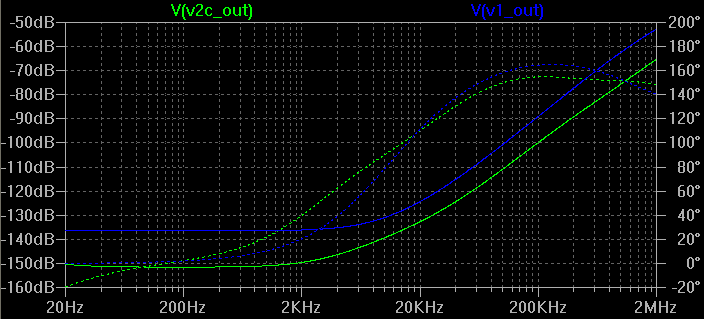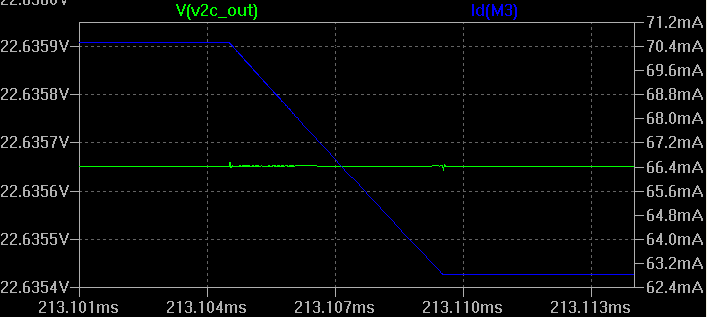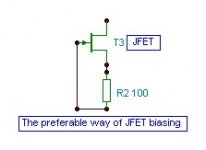And here is James's latest PCB f revision for V1. Includes LEDs option and of course it can be made symmetric using the same board. Just read his comments and figures carefully.
An externally hosted image should be here but it was not working when we last tested it.
An externally hosted image should be here but it was not working when we last tested it.
I agree, v1 will fit the bill very well for most people, and it is a proven design sound wise as well.
A few comments about v2c. In reality I used a 47pF Ccomp, and variable resistors: 1k Rcomp1, and 100R Rcomp2. Different current loads and/or Rset might require a different Ccomp, Rcomp1, and Rcomp2 values. It might be difficult for someone without an oscilloscope to set these. Even v1 oscillated on me having forgotten the output capacitor. I'll think about some sort of oscillation indicator for people that don't have a scope. Any idea?
R6, R7, and R16 are dummy resistor that were left behind from trying things in simulation. They don't exist in my prototype. Also, in the prototype I didn't use BC550B for Q1 and Q3, but a couple of 2SC828R salvaged from an old circuit, but I don't think that the BC550B would pose any problems. I used yellow LEDs, with a voltage drop of about 1.8V each.
A few things about the tests I ran; the results apply to v1 and v2c. A very simple setup using a 20k variable resistor, an IRFZ40, and a 4uF polypropylene capacitor was setup as the load. The variable resistor provided the bias for the mosfet as shown above in one of the pics. I tried various load currents, mostly between 40 and 125mA. On top of this current I overlayed a sine variable current by coupling my signal generator via the capacitor to the mosfet's gate. Tried RMS load currents between 20mA and 90mA. For instance, a 70mA RMS current caused a 200uV ripple at the output of the regulator. The regulator was fed by about 26VDC, with possibly 1V p-p ripple; was not very careful about filtering it. Unfortunately my ancient HP200C signal generator does not do more than 20kHz so I've tested the regulator up to that frequency. My scope's most sensitive setting is 100uV/cm. When the load was below 20mA AC, the output ripple was so small that I could not say what value it was, perhaps 30-40uV and smaller.
so I've tested the regulator up to that frequency. My scope's most sensitive setting is 100uV/cm. When the load was below 20mA AC, the output ripple was so small that I could not say what value it was, perhaps 30-40uV and smaller.
I will continue working on v2c, to finalize it somehow. I probably said already, I've been using a v1 on my salas phono stage for some time and don't see a reason to replace it. However, I've been thinking of a headphone amp, jfet/mosfet perhaps, that might benefit from v2c; not sure yet.
Edit: James, awesome job, thanks for all the effort you put into this. I'll have to have a careful look at it, but it looks good so far!
A few comments about v2c. In reality I used a 47pF Ccomp, and variable resistors: 1k Rcomp1, and 100R Rcomp2. Different current loads and/or Rset might require a different Ccomp, Rcomp1, and Rcomp2 values. It might be difficult for someone without an oscilloscope to set these. Even v1 oscillated on me having forgotten the output capacitor. I'll think about some sort of oscillation indicator for people that don't have a scope. Any idea?
R6, R7, and R16 are dummy resistor that were left behind from trying things in simulation. They don't exist in my prototype. Also, in the prototype I didn't use BC550B for Q1 and Q3, but a couple of 2SC828R salvaged from an old circuit, but I don't think that the BC550B would pose any problems. I used yellow LEDs, with a voltage drop of about 1.8V each.
A few things about the tests I ran; the results apply to v1 and v2c. A very simple setup using a 20k variable resistor, an IRFZ40, and a 4uF polypropylene capacitor was setup as the load. The variable resistor provided the bias for the mosfet as shown above in one of the pics. I tried various load currents, mostly between 40 and 125mA. On top of this current I overlayed a sine variable current by coupling my signal generator via the capacitor to the mosfet's gate. Tried RMS load currents between 20mA and 90mA. For instance, a 70mA RMS current caused a 200uV ripple at the output of the regulator. The regulator was fed by about 26VDC, with possibly 1V p-p ripple; was not very careful about filtering it. Unfortunately my ancient HP200C signal generator does not do more than 20kHz
I will continue working on v2c, to finalize it somehow. I probably said already, I've been using a v1 on my salas phono stage for some time and don't see a reason to replace it. However, I've been thinking of a headphone amp, jfet/mosfet perhaps, that might benefit from v2c; not sure yet.
Edit: James, awesome job, thanks for all the effort you put into this. I'll have to have a careful look at it, but it looks good so far!

Hi friends .. and the other un-lucky ones, as well!
ikoflexer
I see from your analys/test that ripple rejection is excellent, too.
And this is a very good thing. And what I would want.
Nice PCB for anyone to copy and use.
What more can we members here want .. for free .. in the True diy Audio way
regars - Lineup 'linie' LineUp i am a cool & friendly guy .. unless you are a jeeerrrk
i am a cool & friendly guy .. unless you are a jeeerrrk
ikoflexer
I see from your analys/test that ripple rejection is excellent, too.
And this is a very good thing. And what I would want.
Nice PCB for anyone to copy and use.
What more can we members here want .. for free .. in the True diy Audio way
regars - Lineup 'linie' LineUp
Lumba Ogir said:ikoflexer,
you better build readily available circuits without changing anything, since you seemingly are not in a position to make improvements.
And since lineup mentioned psrr.

The transition response of v2c to a square wave load.

ikoflexer said:A few comments about v2c. In reality I used a 47pF Ccomp, and variable resistors: 1k Rcomp1, and 100R Rcomp2. Different current loads and/or Rset might require a different Ccomp, Rcomp1, and Rcomp2 values. It might be difficult for someone without an oscilloscope to set these. Even v1 oscillated on me having forgotten the output capacitor. I'll think about some sort of oscillation indicator for people that don't have a scope. Any idea?
I would fix its compensation for say 150mA, which is ample for most non power circuits, and gives logical heat. Then if someone wants more, has got to be a bit hands on I guess. You tweaked it to V2 for the more demanding in bandwidth, and bandwidth leads to more practical considerations as always. The difference in output impedance is already under a threshold that the cabling and/or traces and connectors will dominate. Also some stray inductance can compromise the bandwidth, those going for V2 must plug it with pins on the load board for best results. The judgment call is if a circuit has the low PSRR beyond audio band, extension, and load swing to sound better with the V2 or not. And that is up to the user to decide in a particular system concept. Then there is the more components and stages thing. Buffering means another local loop for instance, maybe they sound different even on non demanding loads as well. But in some time by using them on your circuits with good resolution headphones you will be able to tell us. Good work. Congratulations once more.
Thank you salas! You're a kind man. Here I come with all kind of ideas which may be bad in the end, and you've been very nice about it.
I agree 100%, sometimes it may seem like we got these amazing results, but simulation is not reality. The most that a simulation can tell us is that there is some potential there. To achieve it, that's another matter. Any modification may change the sound. People can decide for themselves on this matter. I have listened for the last few hours to v2c powering the phono preamp (fixed my headphone amp
 ) and it sounds excellent, can't find it a fault (and neither could I find a fault with v1). But I've told you before that I don't trust my ears so much; other people's ears are more sophisticated.
) and it sounds excellent, can't find it a fault (and neither could I find a fault with v1). But I've told you before that I don't trust my ears so much; other people's ears are more sophisticated.
I'll get back with some suggested values for 150mA idle current through the shunt.
I agree 100%, sometimes it may seem like we got these amazing results, but simulation is not reality. The most that a simulation can tell us is that there is some potential there. To achieve it, that's another matter. Any modification may change the sound. People can decide for themselves on this matter. I have listened for the last few hours to v2c powering the phono preamp (fixed my headphone amp

I'll get back with some suggested values for 150mA idle current through the shunt.
Sorry, you'll have to make your own judgement about it, with the phono stage I could not tell the difference. I can send the circuit to you or Ricardo, you guys have good years, me not so good 
Most likely there is a difference, but well, I'll just blame very loud AC/DC when I was young
Most likely there is a difference, but well, I'll just blame very loud AC/DC when I was young
Those guys still rock, they were in TO not long ago, but I no longer can deal with it.
So one of the tests for me is the natural sound of wind instruments music, like pan flute. And I don't know anybody as good ever as Gheorghe Zamfir was on the pan flute. Not his cheesy music of the last few years, but his early stuff. There are some records, only him and a guy on the organ, simple, good sound, and very well recorded. Anyway, it sounds very natural to me. Smooth, detailed, and dynamic.
So one of the tests for me is the natural sound of wind instruments music, like pan flute. And I don't know anybody as good ever as Gheorghe Zamfir was on the pan flute. Not his cheesy music of the last few years, but his early stuff. There are some records, only him and a guy on the organ, simple, good sound, and very well recorded. Anyway, it sounds very natural to me. Smooth, detailed, and dynamic.
ikoflexer said:Thank you salas! You're a kind man. Here I come with all kind of ideas which may be bad in the end, and you've been very nice about it.
I agree 100%, sometimes it may seem like we got these amazing results, but simulation is not reality.
The most that a simulation can tell us is that there is some potential there.
-
I'll get back with some suggested values for 150mA idle current through the shunt.
> The most that a simulation can tell us is that there is some potential there.
Exactly:
Indication of potential .. this is why I use my Sims
... whatwever those other idiots say and does not use or only use Golden GOLDEN EARS, that are so superior??
regards, lineup your audio friend, salas
Zamphir and Ac Dc in one sentence is a strange thing.
About the time of the Rockers out here, G Zamphir was here for the making of the film "Picnic at Hanging Rock" and has visited often - his haunting music is never forgotten, particularly with the musicians from his home - we had the guys over from the Andes during these years, too - good stuff - music that you feel, rather than listen to.
The first AcaDac coming home concert sold out in 9 minutes! I kid you not - the second one went in a few more! The boys are always a favourite here.
I had a strange idea - would anyone want the pcb in a smaller size - can easily stand the resistors up vertically, use smaller footprint caps like PanaFCs, etc, and perhaps smaller connectors like the 1/4" QC (the push on spades) and such - could add two together for a combined +/- supply and include a pair of Cmultipliers just for fun.
Anyone want something like this as most of it's already been "roughed out".
Ikoflexor,
I had a major melt down in the hearing department a few years ago - each ear developed it's own different tinitus noise that changed randomly, then the thing called "CPS" (can't pick out any sound with another background one - can't understand talking in a quiet car for example) and then just to add the finishing touches, the continuous falling no balance thing came to roost. Over a few months, I became deaf without being deaf, lame without a frame, and very, very P'd off with life.
Unfortunately, conventional medicine has no answers, apart from lightening your wallet with fancy aids and such but ....
Over in France a guy called Dr Tomatis (Ear doctor) found a way over 50 years ago to solve a lot of these problems and developed the " Tomatis Sound Therapy" - there's a centre in Montreal, I think - might be worth a call.
I've feel this is gonna be a good week - now I just have to avoid the world until SundaY!
About the time of the Rockers out here, G Zamphir was here for the making of the film "Picnic at Hanging Rock" and has visited often - his haunting music is never forgotten, particularly with the musicians from his home - we had the guys over from the Andes during these years, too - good stuff - music that you feel, rather than listen to.
The first AcaDac coming home concert sold out in 9 minutes! I kid you not - the second one went in a few more! The boys are always a favourite here.
I had a strange idea - would anyone want the pcb in a smaller size - can easily stand the resistors up vertically, use smaller footprint caps like PanaFCs, etc, and perhaps smaller connectors like the 1/4" QC (the push on spades) and such - could add two together for a combined +/- supply and include a pair of Cmultipliers just for fun.
Anyone want something like this as most of it's already been "roughed out".
Ikoflexor,
I had a major melt down in the hearing department a few years ago - each ear developed it's own different tinitus noise that changed randomly, then the thing called "CPS" (can't pick out any sound with another background one - can't understand talking in a quiet car for example) and then just to add the finishing touches, the continuous falling no balance thing came to roost. Over a few months, I became deaf without being deaf, lame without a frame, and very, very P'd off with life.
Unfortunately, conventional medicine has no answers, apart from lightening your wallet with fancy aids and such but ....
Over in France a guy called Dr Tomatis (Ear doctor) found a way over 50 years ago to solve a lot of these problems and developed the " Tomatis Sound Therapy" - there's a centre in Montreal, I think - might be worth a call.
I've feel this is gonna be a good week - now I just have to avoid the world until SundaY!
James, sorry to hear about that and hope you find a way to get better. So many times we take for granted what we have. Hang in there dude, life is full of surprises. You never know, and don't lose your hope. Might sound stupid, but wearing those soft ear plugs can give your hearing a good break from the crazy sounds of the city, or environment in general.
Ah, good evening to you over there!
I forgot to mention it, but I now have nearly perfect hearing, no tinnitus at all, no CPS, no Minnears symtoms (that ghastly "continuous falling" feeling) and even better, can again "sort out" a Stuart piano!(one of our really good musical developments - apart from ACDC, of course!)
I find that the piano makes it much easier to judge the balance of the sound in the system, particularly the room acoustics - the remarkable clarity and lack of "tone masking" of the Stuart makes it easy to sort out the harmonics. (It's on top of my Wish List!)
I remember you telling me to avoid using a series reg before this shunt (or maybe "maxlorenz, that we haven't heard from in a while) but as the Cmultiplier is actually a part of the CT rectifier section, am trying this out now with the IRF(9)610s - I thought that it'd be good if the input ripple to the reg was just a few mV (or less) and still had the sikorel & polypropylene cap sound from the Cmx. Then maybe I can use a more common F&T (Mundorf), Nichicon, Pana, etc for main supply caps.
I still have the Salas Hi-volt shunt to do for the valve Xover (Acheron, maybe) and have only a few really good high volt Electro caps. Times are tough, gotto economise a bit, ya know.
Good of you to do all the Sim work - I reckon it's the greatest shortcut ever developed - still, it takes up a lot of time, yes? And even better that you went to the trouble to check out the ccts with a prototype. That was one of the problems with the development of Colin Toole's reg design, IMO.
Even tho you don't hear from many of the folks that read these designs (and for years into future) your work is very much appreciated - between the pair of you (and other contributors, too), this reg is a practical reality.
I forgot to mention it, but I now have nearly perfect hearing, no tinnitus at all, no CPS, no Minnears symtoms (that ghastly "continuous falling" feeling) and even better, can again "sort out" a Stuart piano!(one of our really good musical developments - apart from ACDC, of course!)
I find that the piano makes it much easier to judge the balance of the sound in the system, particularly the room acoustics - the remarkable clarity and lack of "tone masking" of the Stuart makes it easy to sort out the harmonics. (It's on top of my Wish List!)
I remember you telling me to avoid using a series reg before this shunt (or maybe "maxlorenz, that we haven't heard from in a while) but as the Cmultiplier is actually a part of the CT rectifier section, am trying this out now with the IRF(9)610s - I thought that it'd be good if the input ripple to the reg was just a few mV (or less) and still had the sikorel & polypropylene cap sound from the Cmx. Then maybe I can use a more common F&T (Mundorf), Nichicon, Pana, etc for main supply caps.
I still have the Salas Hi-volt shunt to do for the valve Xover (Acheron, maybe) and have only a few really good high volt Electro caps. Times are tough, gotto economise a bit, ya know.
Good of you to do all the Sim work - I reckon it's the greatest shortcut ever developed - still, it takes up a lot of time, yes? And even better that you went to the trouble to check out the ccts with a prototype. That was one of the problems with the development of Colin Toole's reg design, IMO.
Even tho you don't hear from many of the folks that read these designs (and for years into future) your work is very much appreciated - between the pair of you (and other contributors, too), this reg is a practical reality.
jameshillj said:
Ikoflexor,
I had a major melt down in the hearing department a few years ago - each ear developed it's own different tinitus noise that changed randomly, then the thing called "CPS" (can't pick out any sound with another background one - can't understand talking in a quiet car for example) and then just to add the finishing touches, the continuous falling no balance thing came to roost. Over a few months, I became deaf without being deaf, lame without a frame, and very, very P'd off with life.
Unfortunately, conventional medicine has no answers, apart from lightening your wallet with fancy aids and such but ....
-----
I've feel this is gonna be a good week - now I just have to avoid the world until SundaY!
ikoflexer said:James, sorry to hear about that and hope you find a way to get better.
So many times we take for granted what we have. Hang in there dude, life is full of surprises. You never know, and don't lose your hope.
Might sound stupid, but wearing those soft ear plugs can give your hearing a good break from the crazy sounds of the city, or environment in general.
Hello.
I have had constant tinitus for over 10 years now.
Not much they can do.
Best thing is for to WARN the Young .. be careful with high volumes
.. especially HEAD PHONES! Freestyles, mp3 etc etc.
You only have one pair of EARS.
You'll never get new ears .. never in your life.
Take good care of your hearing. Please
Sometimes I notice this sound more, sometimes less .. but it is there.
All the time!
Seems you get used in some way to a degree
.. so you at times regard it as a 'natural background sound'.
Annoying
 Extremely!
Extremely!/your lineup
- Status
- This old topic is closed. If you want to reopen this topic, contact a moderator using the "Report Post" button.
- Home
- Amplifiers
- Power Supplies
- The simplistic Salas low voltage shunt regulator


